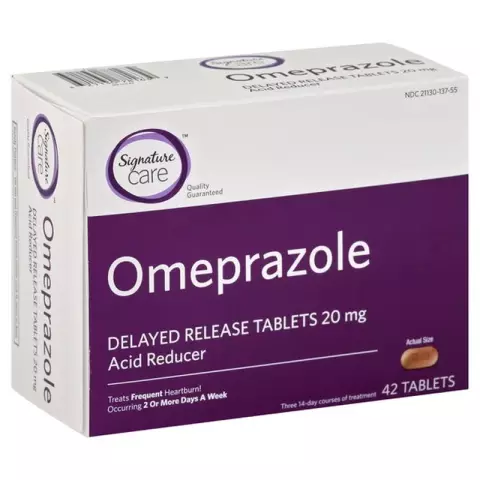- Author Rachel Wainwright [email protected].
- Public 2023-12-15 07:39.
- Last modified 2025-11-02 20:14.
Omeprazole
Omeprazole: instructions for use and reviews
- 1. Release form and composition
- 2. Pharmacological properties
- 3. Indications for use
- 4. Contraindications
- 5. Method of application and dosage
- 6. Side effects
- 7. Overdose
- 8. Special instructions
- 9. Application during pregnancy and lactation
- 10. Use in childhood
- 11. In case of impaired renal function
- 12. For violations of liver function
- 13. Drug interactions
- 14. Analogs
- 15. Terms and conditions of storage
- 16. Terms of dispensing from pharmacies
- 17. Reviews
- 18. Price in pharmacies
Latin name: Omeprazole
ATX code: A02BC01
Active ingredient: omeprazole (omeprazole)
Producer: LLC OZON (Russia), PJSC Farmak (Ukraine), Gedeon Richter Plc. (Hungary), PJSC Kievmedpreparat (Ukraine), TEVA Pharmaceutical Industries, Ltd. (Israel)
Description and photo update: 2019-14-08
Prices in pharmacies: from 21 rubles.
Buy

Omeprazole is an antiulcer drug.
Release form and composition
Omeprazole dosage forms:
- Capsules: gelatinous solid, opaque, size No. 2; body - white, lid - red; capsules contain spherical pellets of white with a cream shade or white (7 pcs. in blisters, 2-4 packs in a cardboard box; 10 pcs. in blisters, 1-3 packs in a cardboard box; 15 pcs. In blisters, 1-4 packages in a cardboard box);
- Enteric capsules (7, 10, 14 or 15 pcs. In blisters, 1-5, 8 or 10 packs in a cardboard box; 14, 10 or 30 pcs. In polymer cans, 1 can in a cardboard box; 20, 30, 40, 50, 100 pcs. in polymeric containers, 1, 10 or 20 containers in a cardboard box).
1 capsule contains:
- Active ingredient: omeprazole - 20 mg;
- Additional components: titanium dioxide, sodium lauryl sulfate, gelatin, nipagin, nipazole, glycerin, dye E 129, purified water.
The composition of 1 enteric capsule contains:
- Active ingredient: omeprazole - 20 mg;
- Additional components: sodium carboxymethyl starch (type A), povidone K-30, sodium hydroxide, copolymer of ethyl acrylate and methacrylic acid [1: 1], titanium dioxide (E171), sugar crumbs (starch syrup, sucrose), sodium lauryl sulfate, sodium phosphate dodecahydrate, hypromellose, triethyl citrate, talc;
- Gelatin capsule (body and lid): titanium dioxide (E171), gelatin, water.
Pharmacological properties
Pharmacodynamics
Omeprazole is a proton pump inhibitor that reduces the production of hydrochloric acid by inhibiting H + / K + -ATPase of gastric parietal cells. The drug is a prodrug that is activated in the acidic biological environment of the secretory tubules of the parietal cell of the gastric mucosa.
As a result of the action of the drug, the basal and stimulated secretion decreases, regardless of the nature of the stimulus. After taking Omeprazole at a dose of 20 mg, the antisecretory effect is manifested within the first hour (maximum after 2 hours). During the day, 50% of the maximum secretion is inhibited. As a result of a single dose, a rapid effective suppression of night and daytime gastric secretion is provided, which reaches a maximum after 4 days of therapy and disappears 3-4 days after the end of the intake. In case of duodenal ulcer, after taking Omeprazole at a dose of 20 mg for 17 hours, the intragastric pH is maintained at 3.
Pharmacokinetics
Omeprazole is rapidly absorbed from the gastrointestinal tract. The maximum concentration in blood plasma is reached after 30-60 minutes. Bioavailability - 30-40% (in patients with hepatic insufficiency increases to almost 100%). The substance is highly lipophilic and easily penetrates parietal cells. Bioavailability with repeated administration is 60-70%, depending on the dose taken. Approximately 90% of the drug binds to plasma proteins.
Almost 100% of omeprazole is metabolized in the liver with the participation of the CYP2C19 enzyme system, resulting in the formation of 6 pharmacologically inactive metabolites (sulfide, sulfone derivatives, hydroxyomeprazole and others). Omeprazole is an inhibitor of the isoenzyme CYP2C19.
Basically, the drug is excreted in the form of metabolites by the kidneys (70-80%) and with bile (20-30%). The half-life is 30-60 minutes (with hepatic insufficiency - 180 minutes), the clearance is 500-600 ml / min. Excretion in the case of chronic renal failure decreases in proportion to the decrease in creatinine clearance. In elderly patients, excretion decreases, and bioavailability increases.
Indications for use
- Reflux esophagitis;
- Pancreatic adenoma ulcerogenic (Zollinger-Ellison syndrome);
- Peptic ulcer of the stomach and duodenum;
- Stress ulcers;
- Erosive and ulcerative lesions of the stomach and duodenum associated with Helicobacter pylori (as part of complex treatment);
- Erosive and ulcerative lesions of the stomach and duodenum associated with the use of non-steroidal anti-inflammatory drugs.
Contraindications
- Age up to 18 years (except for duodenal ulcer associated with Helicobacter pylori (approved for use in children over 4 years old), and gastroesophageal reflux disease (approved for use in children over 2 years old with a body weight of at least 20 kg);
- The period of pregnancy and lactation (breastfeeding);
- Hypersensitivity to drug components.
Instructions for the use of Omeprazole: method and dosage
Omeprazole is taken orally with a small amount of water. Do not chew the capsule. Simultaneous intake with food does not affect the effectiveness of the drug.
Recommended dosage regimen:
- Erosive-ulcerative esophagitis and exacerbation of gastric ulcer: daily dose - 20-40 mg, course duration - 1-2 months;
- Exacerbation of duodenal ulcer: daily dose - 20 mg (if necessary, in resistant cases - up to 40 mg), course duration - 14-28 days;
- Lesions of the gastrointestinal tract of an erosive and ulcerative nature associated with the use of non-steroidal anti-inflammatory drugs: daily dose - 20 mg, course duration - 1-2 months;
- Destruction of Helicobacter pylori (eradication of Helicobacter pylori): daily dose - 40 mg (2 divided doses), course duration - 7 days in combination with antibacterial drugs;
- Adenoma of the pancreas is ulcerogenic: the dose is selected based on the initial level of gastric secretion; the average initial daily dose is 60 mg, then it is increased to 80-120 mg (in 2 divided doses);
- Reflux esophagitis (with anti-relapse goals): daily dose - 20 mg, course duration - up to six months;
- Peptic ulcer of the stomach and duodenum (with anti-relapse): daily dose - 20 mg.
Side effects
The side effects that occur during the use of Omeprazole are usually reversible.
In rare cases, the following violations may occur:
- Allergic reactions: angioedema, anaphylactic shock, urticaria, bronchospasm, interstitial nephritis;
- Nervous system: depression, headache, dizziness, agitation, insomnia, drowsiness, paresthesia, hallucinations; against the background of severe concomitant somatic diseases or in the presence of anamnestic data on severe liver diseases - encephalopathy;
- Digestive system: stomatitis, constipation or diarrhea, dry mouth, vomiting, nausea, abdominal pain, flatulence, taste disturbances, transient increase in the level of liver enzymes in plasma; in the presence of anamnestic data on severe liver diseases - functional liver disorders, hepatitis (including jaundice);
- Hematopoietic system: thrombocytopenia, leukopenia; rarely - pancytopenia, agranulocytosis;
- Musculoskeletal system: myalgia, muscle weakness, arthralgia;
- Skin: itching; rarely - erythema multiforme, photosensitivity, alopecia;
- Others: gynecomastia, fever, peripheral edema, blurred vision, increased sweating; rarely, during long-term therapy, the formation of gastric glandular cysts (benign reversible).
Overdose
Symptoms: arrhythmia, tachycardia, blurred vision, confusion, drowsiness, headaches, dry mouth, nausea.
Treatment: symptomatic therapy. There is no specific antidote.
Due to the high degree of binding of the active substance with plasma proteins, the removal of Omeprazole from the body by hemodialysis is not effective enough.
special instructions
Before prescribing Omeprazole, it is necessary to exclude a malignant process (especially with a stomach ulcer), since the use of the drug masks the symptoms and may delay the correct diagnosis.
If it is difficult to swallow Omeprazole, the capsule can be opened or sucked and the contents swallowed. Also, the pellets contained in the capsule can be mixed with a slightly acidified liquid, for example, yogurt or juice (the resulting suspension should be used within 30 minutes).
In case of liver failure in severe course, it is not recommended to take Omeprazole in a dose exceeding 20 mg.
Application during pregnancy and lactation
During pregnancy, Omeprazole can only be used in cases where the perceived risk to the fetus is lower than the potential benefit to the mother.
The drug is excreted in breast milk. If it is necessary to use Omeprazole during lactation, breastfeeding should be discontinued.
Pediatric use
It is forbidden to use the drug to treat patients under the age of 18 years.
With impaired renal function
In renal failure, Omeprazole should be used with caution.
For violations of liver function
According to the instructions, Omeprazole should be used with caution in liver failure.
Drug interactions
Long-term simultaneous use of 20 mg of Omeprazole per day in combination with metoprolol, diclofenac, quinidine, caffeine, cyclosporine, theophylline, piroxicam, propranolol, naproxen, ethanol, estradiol, lidocaine does not lead to a change in their plasma concentration.
Interaction with antacids with combined use was not noted.
Omeprazole can affect the bioavailability of substances / drugs, the absorption of which depends on the pH value.
Analogs
Analogs of Omeprazole are: Omeprazole-Acri, Omeprazole-Akrikhin, Omeprazole-Teva, Omeprazole-Richter, Omeprazole-Stada, Gastrozole, Zerocid, Omez, Omipiks, Omitox, Omizak, Ortanol, Promez, Ultopol, Helicid, Helicid Lancid, Pariet, Parkour, Ontime, Nolpaza, Nexium, Ultera, Epicur, Neo-Zext, Razo, Peptazol, Pantoprazole, Rabeprazole, De-Nol, Esomeprazole.
Terms and conditions of storage
Store in a dark, dry place out of reach of children at temperatures up to 25 ° C.
Shelf life is 2 years.
Terms of dispensing from pharmacies
Dispensed by prescription.
Reviews of Omeprazole
Reviews of Omeprazole from doctors are mostly positive. Experts note that the drug is safe, effective and affordable for most patients.
The price of Omeprazole in pharmacies
The approximate price for Omeprazole is 40 rubles. (30 capsules in the package).
Omeprazole: prices in online pharmacies
|
Drug name Price Pharmacy |
|
Omeprazole 20 mg capsule 14 pcs. RUB 21 Buy |
|
Omeprazole 20 mg enteric capsules 10 pcs. RUB 24 Buy |
|
Omeprazole 20 mg enteric capsules 10 pcs. RUB 24 Buy |
|
Omeprazole 20 mg capsule 30 pcs. RUB 27 Buy |
|
Omeprazole 20 mg capsule 30 pcs. 28 RUB Buy |
|
Omeprazole 20mg capsules 30 pcs. RUB 36 Buy |
|
Omeprazole capsules enteric solution. 20mg 20 pcs. RUB 36 Buy |
|
Omeprazole 20 mg enteric capsules 20 pcs. RUB 36 Buy |
|
Omeprazole capsules enteric solution. 20mg 30 pcs. RUB 37 Buy |
|
Omeprazole 20 mg enteric capsules 30 pcs. RUB 38 Buy |
|
Omeprazole 20 mg capsule 30 pcs. RUB 48 Buy |
|
Omeprazole caps. 20mg n30 RUB 51 Buy |
|
Omeprazole 20mg capsules 30 pcs. RUB 61 Buy |
|
Omeprazole 20 mg capsule 30 pcs. RUB 61 Buy |
|
Omeprazole capsules 20mg 30pcs RUB 63 Buy |
|
Omeprazole 40 mg lyophilisate for preparation of solution for infusion 1 pc. 120 RUB Buy |
| See all offers from pharmacies |

Anna Kozlova Medical journalist About the author
Education: Rostov State Medical University, specialty "General Medicine".
Information about the drug is generalized, provided for informational purposes only and does not replace the official instructions. Self-medication is hazardous to health!






